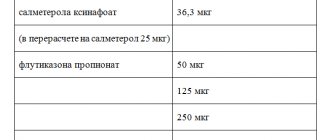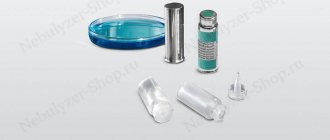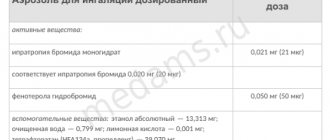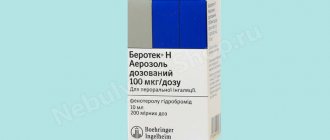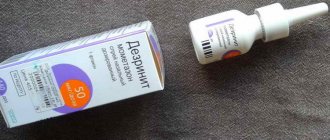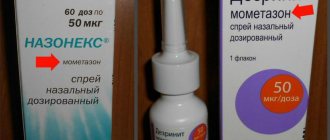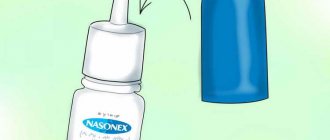Release form and components
The drug Flixotide
The drug Flixotide is sold in the form of an aerosol, which is used for inhalation. The product is produced in aluminum bottles with a dosing device that sprays the medicinal substance. The volume of the bottle can contain 60 doses or 120 doses. The suspension can also be produced in 2 ml nebulas.
The main active component of the drug is fluticasone propionate. Tetrafluoroethane acts as an excipient. Each dose of the drug includes 50 mcg, 125 mcg or 250 mcg of the active substance. The medicinal liquid is presented as a white, odorless suspension.
Price for Flixotide
Currently, state registration in Russia applies only to Flixotide metered-dose aerosols; they can be purchased in pharmacies at the following average prices:
- 50 mcg/dose, inhaler for 120 doses – 675 rubles;
- 125 mcg/dose, inhaler for 60 doses – 980 rubles;
- 250 mcg/dose, inhaler 60 doses – 1400 rubles.
Flixotide nebulas do not have a valid registration certificate, therefore they are not available in pharmacies.
We recommend reading about the main types of inhalers. From the article you will learn about what inhalers are used for, their mechanism of action, types of inhalers for children and their characteristics. And here is more information about how to use Pulmicort for inhalation.
Flixotide is a hormonal inhaler for the treatment of asthma, it helps prevent attacks and reduce reactions to allergens. Used for children from one year old, approved for pregnant women and rarely causes systemic (general) adverse reactions. This is explained by the fact that the main effect occurs in the lumen of the bronchi.
Pharmacological effect
Aerosol Flixotide has an anti-inflammatory and antiallergic effect on lung tissue. Glucocorticosteroids included in the drug reduce the manifestations of bronchial asthma and reduce pulmonary obstruction in diseases of the respiratory tract: emphysema, bronchitis. The active substance reduces the synthesis of inflammatory mediators - anti-inflammatory therapy is based on this.
Note! When using Flixotide, there is no need to use additional glucocorticosteroids in tablet form.
Aerosol Flixotide improves pulmonary function
The medicine affects pulmonary function, reducing the severity of painful symptoms and reducing the frequency of attacks. With systematic use of the drug, the therapeutic effect appears 4 days after the start of treatment with Flixotide.
The bioavailability of the active ingredient during inhalation is 30%. A small amount of the drug enters the gastrointestinal tract. The amount of absorption during inhalation use depends on the dose of the drug.
How to use Flixotide guide
Flixotide for inhalation (aerosol). The product is not allowed to be used by pediatric patients under the first year of life.
Instructions for use with recommended dosages:
Flixotide is recommended for use in children via a nebulizer. Ultrasonic nebulizers are not suitable for inhalation. Inhalation of fluticasone propinate is a preventive measure that should be carried out even during an asymptomatic course of the disease. If there is a decrease in the effectiveness of the bronchodilator, doctors recommend seeking medical help.
- Adult and adolescent patients (from 16 years old) – from 0.5 to 2 mcg of a suspension drug, 2 times a day.
Fluticanazole propinate is more effective at half the dosage of other corticosteroid drugs. For example, 100 mcg of fluticasone is equivalent to 200 mcg of beclomethasone dipropionate (with freon).
When carrying out inhalation, it is very important to observe the dosage of the drug
Initial pediatric doses of inhalations with Fluticasone should correspond to the severity of the patient's pathology. The minimum dosage is reached after effective control of the disease has been established.
- Children's category of patients: 4-16 years – suspension (1 mcg) 2 times a day.
- For elderly patients with hepatic and renal impairment, the dosage does not change.
When gradually withdrawing steroids for systemic treatment, the dosage should be reduced at a maintenance level - an interval of at least 7 days. The maintenance dose of prednisone is up to 10 mg, sometimes less. The dosage reduction should not exceed 1 mcg per day, intervals of 7 days.
Flixotide nebulas are not approved for injection. Most often, the drug is administered using a mouthpiece. This allows you to prevent atrophic changes in the skin on the face that occur with long-term use of face masks.
If a face mask is used, the child’s skin should be protected from the effects of the medication using a cream (protective). After inhalation, doctors recommend washing thoroughly.
Application of Flixotide nebula: the nebula is held by the edge (with markings) in a horizontal position, the other edge is shaken several times. The process is repeated several times until the contents are completely mixed. To open the nebula, you need to unscrew the cap located at the top.
In some cases, the drug is diluted with sodium chloride. Reusing the solution remaining in the nebulizer is prohibited. The remaining solution is disposed of after each inhalation.
When is the drug prescribed?
The use of Flixotide is necessary for:
- bronchial asthma of an inflammatory nature;
- addiction to systemic glucocorticosteroids during therapy for bronchial asthma;
- chronic obstructive respiratory diseases - chronic bronchitis, emphysema.
The drug is included in complex treatment when taking beta-agonists and long-acting bronchodilators.
The drug must be prescribed only by a doctor
Mention of the drug FLIXOTIDE in user posts
September 3, 2021 MAGAZINEFlixotide Girls, who used flixotide? My daughter has bronchial asthma. We have been taking flixotide for 1.5 years. I want to cancel his appointment. We go to a private pediatrician, she promises us that we will cancel the next appointment, but we come, and she does not cancel (extracting money). Who has been stopped taking flixotide?
December 1, 2021 MAGAZINE Which is better: Singulair or Flixotide? Good afternoon. Girls, tell me whose children have asthma. Our therapy was singular. When attacks beradual + pulmicort and physical rast
During Singular and after its withdrawal, the attacks increased and we introduced inhalations. We went to a pulmonologist and she prescribed us a choice of Singular or Flixotide for half a year. She said that Flixotide is a drug containing hormones and it is better to think about what to choose.
Rules of application
Flixotide aerosol is used for oral inhalation administration. Inhalation is carried out twice a day. The initial dose of the drug should be minimal to control the body's response. Thanks to the presence of a spacer, treatment can also be carried out for small children. A spacer is a special chamber into which the aerosol initially enters, and then the person inhales it.
Note! Children should use Flixotide containing 0.05 mg of active substance per dose.
For the treatment of bronchial asthma, it is recommended to use the following single doses:
- children 1-4 years old - 0.1 mg of medication through a spacer;
- children over 4 years old – 0.05-0.1 mg;
- patients over 16 years of age - 0.1-0.25 mg.
The dose of the drug is determined by the doctor in each case individually. The dose depends on the severity of the disease and on the body’s response to fluticasone propionate. After the therapeutic effect appears, the dose is reduced to the minimum.
Treatment of obstructive pulmonary diseases is carried out along with the use of long-acting bronchodilators. The adult dose is 0.5 mg twice daily. The maximum therapeutic effect is achieved after 3-6 months of regular use of the aerosol.
Precautions for use
Flixotide is used only as prescribed by a doctor; during the entire course you must adhere to the following precautions during treatment:
- if the condition suddenly worsens (the need for drugs to relieve an attack has increased), a mandatory examination by a pulmonologist is necessary; hospitalization, an increase in the dose of hormones, or the addition of tablets (for example, Prednisolone) may be required;
- Flixotide does not relieve the onset of an asthma attack, so the patient should have a can of bronchodilators with him;
- inhalations do not replace the need for injections in case of severe exacerbation or status asthmaticus;
- with improvement of well-being and respiratory parameters, the dose of the drug is reduced;
- Abrupt withdrawal is unacceptable, as the symptoms of the disease may recur;
- treatment is carried out to prevent subsequent exacerbations, so it must be continued even if there have been no attacks for a month, but in this case the doctor may reduce the dosage.
Signs of overdose
If the maximum dose of Flixotide (2 mcg) or even a larger amount is taken accidentally, then usually no serious consequences occur. The function of the adrenal cortex and pituitary gland is temporarily disrupted, but as the drug is released, the functioning of the endocrine system is normalized.
At particular risk are children and adolescents under 16 years of age who are prescribed 1 mg of Flixotide per day on an ongoing basis. They suppress the formation of their steroid hormones. It may not manifest itself clinically, but with injury, surgery, infection or abrupt withdrawal, adrenal insufficiency occurs in the form of an acute crisis:
- severe weakness;
- abdominal pain;
- aversion to food;
- nausea, vomiting;
- drop in blood pressure and sugar;
- loss of consciousness or faintness;
- headache;
- convulsive muscle twitching.
Symptoms of low blood sugar
In such cases, additional injections of hormones are necessary.
special instructions
Flixotide in the form of a metered-dose aerosol requires the ability to adjust breathing to the administration of the drug. In practice, about 45% of patients use it incorrectly, this can be noticed by the appearance of a cloud near the mouth (visible in the mirror). This leads to insufficient supply of the hormone and worsens treatment results. Such patients need to purchase a spacer for inhalation. It should also be taken into account that cooling the aerosol leads to a decrease in its effectiveness.
Rules for using Flixotide aerosol
Particular caution is needed when switching from hormone tablets to Flixotide. During this period, allergic rhinitis, skin diseases (eczema or atopic dermatitis, urticaria), and joint diseases that were masked by general hormonal therapy may worsen.
At first, patients begin to feel worse, as the formation of their adrenal hormones gradually normalizes. Therefore, a very slow reduction in the dose of tablets with a gradual replacement of them with Flixotide is recommended.
Contraindications and side effects
Among the side effects from treatment with Flixotide are:
- diseases of an infectious and parasitic nature - pneumonia, candidal stomatitis;
- from the respiratory tract - hoarseness of voice, bronchospasm;
- from the immune defense – skin rashes, swelling of the face, throat;
- from the endocrine system - disruption of the adrenal cortex, growth retardation, cataracts, glaucoma;
- on the mental side – sleep disorders, behavioral problems, aggressiveness;
- on the metabolic side – hyperglycemia.
To reduce the risk of the formation of candidiasis in the oral cavity, it is necessary to rinse your mouth with clean water after inhalation procedures. Candidal stomatitis is treated with local antimycotic drugs.
The aerosol must not be used when:
- individual intolerance to the components of the product;
- asthma;
- acute bronchospasm;
- children under 1 year of age.
Relative contraindications include tuberculosis, osteoporosis, increased intraocular pressure, hypothyroidism.
Overdose
In case of overdose, intoxication occurs, which is expressed in dysfunction of the pituitary gland, hypothalamus, and adrenal glands. If the specified dose is exceeded once, the functioning of the adrenal glands is restored independently. Systematic use of large doses provokes the development of hypoglycemia, adrenal crisis, convulsive syndrome, and confusion.
Intoxication can occur with an overdose of the drug
Use during pregnancy, lactation and childhood
Flixotide should not be used to treat bronchial asthma by women in the first trimester of pregnancy. There is no information on the safety of the active ingredient when using the drug in the second or third trimester. Despite the fact that fluticasone propionate does not have a mutagenic effect on the embryo, the drug is prescribed to pregnant women only if the benefit to the woman outweighs the possible consequences to the fetus.
Important! Children under one year of age should not be treated with Flixotide.
The possibility of using an aerosol during the lactation period is determined by the attending physician. This is explained by the ability of the active substance to be absorbed into the systemic circulation.
Instructions:
Clinical and pharmacological group
04.005 (GCS for inhalations)
Release form, composition and packaging
Aerosol for inhalation dosed in the form of a suspension of white or almost white color.
| 1 dose | |
| fluticasone propionate | 50 mcg |
| -«- | 125 mcg |
| -«- | 250 mcg |
Excipients: propellant GR106642X (does not contain freon).
60 doses - aluminum inhalers (1) with a metering device - cardboard boxes. 120 doses - aluminum inhalers (1) with a metering device - cardboard boxes.
pharmachologic effect
GCS for inhalation use. In recommended doses, it has a pronounced anti-inflammatory and anti-allergic effect, which leads to a decrease in the severity of symptoms and a decrease in the frequency of exacerbations of diseases accompanied by airway obstruction (bronchial asthma, chronic bronchitis, emphysema).
Fluticasone propionate inhibits the proliferation of mast cells, eosinophils, lymphocytes, macrophages, neutrophils, reduces the production and release of inflammatory mediators and other biologically active substances (histamine, prostaglandins, leukotrienes, cytokines).
In chronic obstructive pulmonary disease (COPD), the effectiveness of inhaled fluticasone propionate on lung function has been confirmed, which is characterized by a decrease in the severity of symptoms of the disease, the frequency and severity of exacerbations, a decrease in the need to prescribe additional courses of GCS in the form of tablets and an increase in the quality of life of patients.
The systemic effect of fluticasone is minimal: in therapeutic doses it has virtually no effect on the hypothalamic-pituitary-adrenal system.
The drug restores the patient's response to bronchodilators, making it possible to reduce the frequency of their use.
The therapeutic effect after inhaled use of fluticasone begins within 24 hours, reaches a maximum within 1-2 weeks or more after the start of treatment and persists for several days after discontinuation.
Pharmacokinetics
Suction
After inhalation administration, the absolute bioavailability of fluticasone propionate is 10-30%, depending on the type of inhaler. Systemic absorption occurs primarily in the lungs. Part of the inhaled dose can be swallowed, but its systemic effect is minimal due to the drug’s poor solubility in water and intensive “first pass” metabolism through the liver (the bioavailability of fluticasone propionate when taken orally is less than 1%). There is a direct relationship between the inhaled dose and the systemic effect of fluticasone propionate.
Distribution
Plasma protein binding is 91%.
Fluticasone propionate has a large Vd - about 300 l.
Metabolism
Fluticasone propionate is metabolized in the liver with the participation of CYP3A4, forming an inactive metabolite.
Removal
Fluticasone propionate has a high plasma clearance of 1150 ml/min. T1/2 is about 8 hours. Renal clearance is less than 0.2%. Less than 5% is excreted in the urine as a metabolite.
Dosage
Flixotide is for inhalation use only. Flixotide is a preventative therapy; the drug must be used regularly, even in the absence of symptoms of the disease.
With basic anti-inflammatory therapy for bronchial asthma, the therapeutic effect of Flixotide occurs 4-7 days after the start of treatment. In patients who have not previously used inhaled corticosteroids, improvement may be observed within 24 hours after starting the drug.
For adults and adolescents over 16 years of age, the initial dose for mild bronchial asthma is 100-250 mcg 2 times a day, moderate severity is 250-500 mcg 2 times a day, severe asthma is 500-1000 mcg 2 times a day. days Then, depending on the patient's individual response to treatment, the initial dose can be increased until clinical effect occurs or reduced to the minimum effective dose.
In children over 4 years of age, it is recommended to use an aerosol containing 50 mcg of fluticasone propionate in 1 dose. It is recommended to prescribe 50-100 mcg 2 times a day. The initial dose of the drug depends on the severity of the disease. Then, depending on the patient's individual response to treatment, the initial dose can be increased until clinical effect occurs or reduced to the minimum effective dose.
For children aged 1 to 4 years, it is recommended to prescribe 100 mcg 2 times a day.
Young children require higher doses of Flixotide compared to older children due to reduced drug intake during inhalation (smaller bronchial lumen, use of a spacer, intense nasal breathing in young children).
The drug is administered using an inhaler through a spacer with a face mask (for example, Babyhaler).
Flixotide dosed aerosol is especially indicated for young children with severe bronchial asthma.
For the treatment of chronic obstructive pulmonary disease, adults are recommended to prescribe 500 mcg 2 times a day.
Patients with impaired liver or kidney function, as well as the elderly, do not require dose adjustment.
Overdose
An acute overdose of the drug can lead to a temporary decrease in the function of the adrenal cortex, which usually does not require emergency treatment, because the function of the adrenal cortex is restored within a few days.
If Flixotide is taken in high doses for a long time, significant suppression of adrenal function is possible. Very rare reports have been received of the development of adrenal crisis in children receiving fluticasone propionate at a dose of 1 mg/day or higher for several months or years. Such patients experienced hypoglycemia, depression of consciousness, and convulsions.
Acute adrenal crisis can develop against the background of the following conditions: severe injury, surgery, infection, sharp reduction in the dose of fluticasone propionate.
In cases where the patient receives a dose higher than recommended, it should be gradually reduced.
Drug interactions
Since fluticasone propionate plasma concentrations are very low when administered via inhalation, interaction with other drugs is unlikely.
With the simultaneous use of fluticasone propionate and CYP3A4 enzyme inhibitors (for example, ketoconazole, ritonavir), the systemic effect of Flixotide may be enhanced (the use of such a combination requires caution).
Use during pregnancy and lactation
The use of the drug during pregnancy is possible only if the expected benefit to the mother outweighs the potential risk to the fetus.
The excretion of fluticasone into breast milk in humans has not been studied. However, after inhalation administration of the drug in recommended doses, plasma concentrations of fluticasone propionate are low.
Side effects
Local reactions: possible candidiasis of the oral mucosa and pharynx, hoarseness, paradoxical bronchospasm.
Allergic reactions: in some cases - skin rash, angioedema, dyspnea or bronchospasm, anaphylactic reactions.
Systemic reactions: decreased function of the adrenal cortex, osteoporosis, growth retardation in children, cataracts, increased intraocular pressure, glaucoma, Cushing's syndrome, Cushingoid symptoms. There are also very rare reports of hyperglycemia.
Possible: mental disorders (anxiety, sleep disorders, changes in behavior, including hyperactivity and irritability /mainly in children/); often - bruising, pneumonia in patients with COPD.
Storage conditions and periods
List B. The drug should be stored out of the reach of children at a temperature not exceeding 30°C; Do not freeze or expose to direct sunlight. Shelf life: 2 years.
Indications
— basic anti-inflammatory therapy of bronchial asthma (including in severe cases of the disease and dependence on systemic corticosteroids) in adults and children 1 year and older;
- treatment of chronic obstructive pulmonary disease in adults.
Contraindications
- acute bronchospasm;
- status asthmaticus (as a first-line remedy);
- bronchitis of non-asthmatic nature;
- children under 1 year of age;
- hypersensitivity to the components of the drug.
The drug should be prescribed with caution for liver cirrhosis, glaucoma, hypothyroidism, systemic infections (bacterial, fungal, parasitic, viral), osteoporosis, pulmonary tuberculosis, pregnancy and lactation.
special instructions
Flixotide is intended for the long-term treatment of bronchial asthma, and not for the relief of attacks. To relieve attacks, patients should be prescribed short-acting inhaled bronchodilators.
If the effectiveness of short-acting bronchodilators decreases or if more frequent use is necessary, the patient should consult a doctor.
An increased need for the use of short-acting inhaled beta2-adrenergic agonists indicates a worsening of the disease. In such cases, it is recommended to reconsider the patient's treatment plan.
A sudden and progressive deterioration of bronchial asthma can pose a threat to the patient's life, so in such situations it is necessary to urgently address the issue of increasing the dose of GCS.
Abruptly stopping treatment with Flixotide is not recommended.
Particular care should be taken when treating patients with active or inactive forms of pulmonary tuberculosis with inhaled corticosteroids.
In case of severe exacerbation of bronchial asthma or insufficient effectiveness of the therapy, the dose of inhaled fluticasone propionate should be increased and, if necessary, a drug from the group of systemic corticosteroids and/or an antibiotic should be prescribed if infection develops.
It is recommended to check whether the patient knows how to use the inhaler correctly.
With long-term use of any inhaled corticosteroids, especially in high doses, systemic effects may be observed, but the likelihood of their development is much lower than when taking corticosteroids orally. Possible systemic effects include decreased adrenal function, osteoporosis, growth retardation in children, cataracts, and glaucoma. Therefore, it is especially important that when a therapeutic effect is achieved, the dose of inhaled corticosteroids is reduced to the minimum effective dose that controls the course of the disease.
The transfer of patients suffering from hormone-dependent bronchial asthma from systemic corticosteroids to inhaled fluticasone requires special attention, since restoration of adrenal function takes a long time. Adrenal cortex function should be regularly monitored and caution should be exercised when reducing the dose of systemic corticosteroids.
A gradual reduction in the dose of systemic corticosteroids can begin approximately one week after the appointment of fluticasone. With a maintenance dose of prednisolone (or other corticosteroids at an equivalent dose) of less than 10 mg/day, dose reduction should not exceed 1 mg/day and should be carried out at intervals of at least 1 week. With a maintenance dose of prednisolone more than 10 mg/day (calculated per day) - in high doses, also at intervals of at least 1 week.
Some patients, during the period of reducing the dose of systemic corticosteroids, complain of general malaise against the background of stabilization or even improvement of respiratory function indicators. If there are no objective signs of adrenal insufficiency, patients should be persuaded to continue switching to inhaled corticosteroids and gradual withdrawal of systemic corticosteroids.
In some cases, individual high sensitivity to inhaled corticosteroids may be observed. The function of the adrenal cortex when prescribing fluticasone propionate in recommended doses, as a rule, remains within normal limits. The advantages of inhaled fluticasone propionate minimize the need for systemic corticosteroids. However, there may remain a possibility of developing side effects in patients who have previously received or periodically take GCS orally. During resuscitation or surgery, consultation with a specialist may be required to determine the degree of adrenal insufficiency. In such stressful situations, one should always take into account possible adrenal insufficiency and, if necessary, additionally prescribe corticosteroids.
Due to possible adrenal insufficiency, special caution should be exercised and regular monitoring of adrenal function indicators when transferring patients who have taken oral corticosteroids to treatment with inhaled fluticasone propionate. Discontinuation of systemic corticosteroids during inhaled fluticasone propionate should be gradual, and patients should carry a card indicating that they may require additional corticosteroids during periods of stress.
In rare cases, when transferring patients from taking systemic corticosteroids to inhaled therapy, conditions accompanied by hypereosinophilia (for example, Churg-Strauss syndrome) may occur. As a rule, this occurs during dose reduction or withdrawal of systemic corticosteroids, but a direct cause-and-effect relationship has not been established.
When transferring patients from taking systemic corticosteroids to inhalation therapy, concomitant allergic diseases (for example, allergic rhinitis, eczema), which were previously suppressed by systemic drugs, may also worsen. In such situations, it is recommended to carry out symptomatic treatment with antihistamines and/or topical drugs, incl. GCS for local use.
To prevent the development of candidiasis, you should rinse your mouth after using Flixotide; If necessary, local antifungal therapy can be prescribed throughout the entire treatment period.
To prevent hoarseness, it is recommended to rinse your mouth and throat with water immediately after inhalation.
If paradoxical bronchospasm develops, you should immediately stop administering Flixotide, assess the patient's condition, conduct the necessary examination and, if necessary, prescribe other medications. Paradoxical bronchospasm should be treated immediately with a fast-acting inhaled bronchodilator.
There are very rare reports of increased blood glucose levels, and this should be kept in mind when prescribing fluticasone propionate to patients with diabetes mellitus.
Like most other inhalation aerosol products, this product may be less effective if the canister is refrigerated.
Use in pediatrics
The growth dynamics of children receiving inhaled corticosteroids for a long time should be regularly monitored.
Impact on the ability to drive vehicles and operate machinery
The effect of fluticasone propionate on the ability to drive a car and operate machinery is unlikely.
Use for renal impairment
Patients with impaired renal function do not require dose adjustment.
Use for liver dysfunction
Patients with impaired liver function do not require dose adjustment.
Conditions for dispensing from pharmacies
The drug is available with a prescription.
Registration numbers
• aerosol for inhalation. dosed 125 mcg/1 dose: inhalers 60 or 120 doses P N015734/01 (2018-05-09 – 0000-00-00) • aerosol for inhalation. dosed 125 mcg/1 dose: inhalers 60 doses or 120 doses P N015734/01 (2018-05-09 – 0000-00-00) • aerosol for inhalation. dosed 250 mcg/1 dose: inhalers 60 or 120 doses P N015734/01 (2018-05-09 – 0000-00-00) • aerosol for inhalation. dosed 250 mcg/1 dose: inhalers 60 doses or 120 doses P N015734/01 (2018-05-09 – 0000-00-00) • aerosol for inhalation. dosed 50 mcg/1 dose: inhalers 60 or 120 doses P N015734/01 (2018-05-09 – 0000-00-00) • aerosol for inhalation. dosed 50 mcg/1 dose: inhalers 60 doses or 120 doses P N015734/01 (2018-05-09 – 0000-00-00)
Drug interactions
With the parallel use of Ritonavir and Flixotide, the concentration of fluticasone propionate in the blood plasma increases and the amount of cortisol in the blood serum decreases. Doctors prescribe Flixotide and Ketoconazole with caution, as the risk of side effects increases. The aerosol can be used simultaneously with bronchodilators, as the drug increases their therapeutic effect.
Additional nuances
To make using Flixotide as comfortable and effective as possible, you need to remember some important little things:
- after inhalation with the drug you can drive a car;
- You can take any other medications along with the drug, since it is contained in the blood in small quantities and does not interact;
- Flixotide is stored for up to two years, but only if it is not opened - opened nebulas are stored for no longer than a month;
- Flixotide should be stored in a cool room, away from sunlight and so that children and pets cannot reach it;
- aerosol is cheaper than nebula and costs up to a thousand rubles;
- inhalations with Flixotide have a withdrawal syndrome, due to which the patient’s well-being will seriously deteriorate, therefore it is necessary to discontinue gradually reducing the dosage - even if it was exceeded and suppression of the adrenal cortex has developed;
- to prevent candidiasis, it is recommended that immediately after inhalation, rinse your mouth with clean water - either boiled or filtered - but under no circumstances swallow;
- if paradoxical bronchospasm develops as a result of inhalation, it should be stopped as quickly as possible (you can call an ambulance if there are no suitable means at hand), and then consult a doctor to change the drug;
- as a result of inhalations, the level of glucose in the blood may increase, so people with diabetes should carry them out with the utmost caution;
- if the patient is a child, it is necessary to constantly monitor the rate of his growth, since Flixotide can slow it down and then a change in drug will be required.
Flixotide is used exclusively as prescribed by a doctor - the possible side effects and diseases for which it is intended to treat are too serious to experiment with them frivolously.
But when used carefully in accordance with the doctor’s recommendations and under his strict supervision, Flixotide significantly improves the patient’s standard of living.
Similar means
Analogues of Flixotide include Budesonide, Nazarel, Cutivate, Sinoflurin, Flixonaz. It is prohibited to independently replace the drug with a similar one. The decision to replace the medicine with another should be made by the doctor.
Budesonide is the most common drug used for the treatment and prevention of bronchial asthma. The medication also contains glucocorticosteroids and is sold in powder form. Among the advantages of Budesonide are the rapid elimination of foci of inflammation and a reduction in the frequency of attacks. Disadvantages include the inability to use in children under 6 years of age and the risk of developing liver cirrhosis.
Flixotide is an aerosol containing glucocorticosteroids, which are necessary for the treatment of bronchial asthma. The drug has pronounced anti-inflammatory and antiallergic activity. There are no side effects if you follow the dosage recommended by your doctor.
